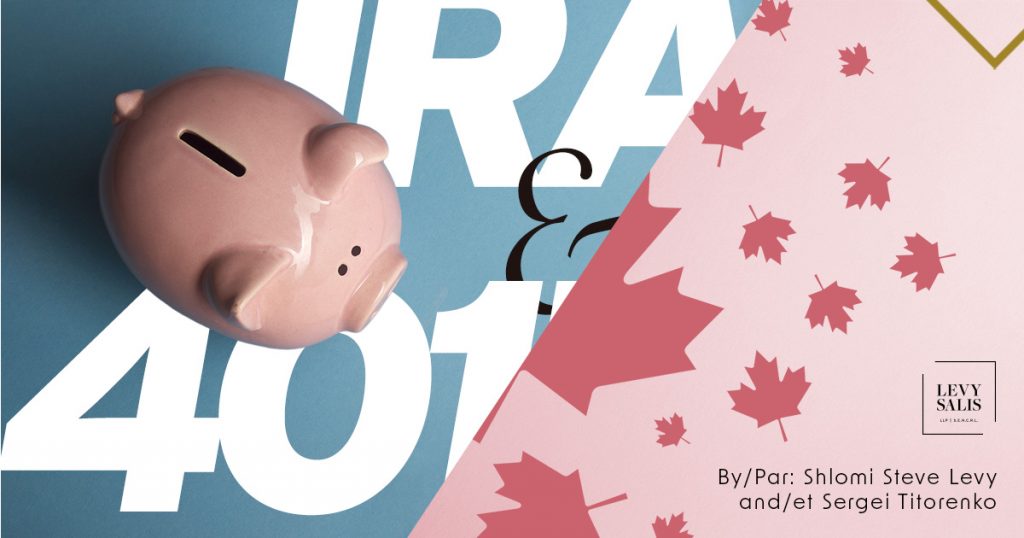Canadians who have previously worked in the United States and have owned IRAs and 401k plans are subject to particular U.S. and Canadian tax obligations with respect to these plans.
It is quite common for Canadians who have worked in the United States to set up U.S. retirement savings plans and decide to maintain these plans following their return to Canada. These plans include Individual Retirement Accounts (IRAs) and 401k plans among others. Canadian holders of these accounts are subject to particular U.S. and Canadian tax rules on these plans. This article provides an overview of these rules and the tax issues applicable to the holders of these accounts. We do not discuss Roth IRAs and Roth 401k plans as these will be discussed in a future publication.
Overview of IRAs and 401k Plans
IRAs and 401k plans are U.S. retirement plans which are similar in a number of respects to Canadian Registered Retirement Savings Plans (RRSPs):
- Tax Deductibility of Contributions: Eligible contributions up to an annual contribution cap are deducible from the account holder’s taxable income under U.S. tax rules. These contribution caps are subject to annual changes. The cap varies on the plan and may be complemented by catch-up contributions for account holders who are 50 years or older.
- Tax Deferral: Growth within an IRA or a 401k plan is exempt from U.S. income tax until withdrawals are made.
- Taxation: Withdrawals by U.S. residents are taxed as ordinary income at U.S. income tax rates of between 10% and 37%, plus any applicable State income tax. Where the account holder is a non-resident, withdrawals are normally subject to a 30% withholding unless the withdrawals are periodic in which case the withholding may be reduced to 15% under the Canada-US Tax Treaty.
- Early Withdrawals: Withdrawals before the age of 59 and ½ years are subject to an early withdrawal penalty of 10%.
- Required Withdrawals: Once the account holder reaches the age of 72 for those born after June 30, 1949, and 70 and ½ years for those born before July 1, 1949, he/she must take required minimum distributions (RMDs) from the plan.
A primary difference between a traditional IRA and a 401k plan is that the former is funded solely by an employee’s contributions whereas the latter is funded by both employee and employer contributions. Only employee contributions to a 401k plan are U.S. tax deductible. While employer contributions to a 401k plan are not U.S. tax deductible, these contributions are not included in the employee’s U.S. taxable income provided they do not exceed applicable annual contribution limits.
We bring to your attention that a traditional IRA should not be confused with a Roth IRA, SEP IRA, a SIMPLE IRA, a 403(b) plan, a 457(b) plan, profit sharing plans or other defined contribution plans. These other plans are subject to distinct U.S. tax rules and to other Canadian tax rules where the account holder is a Canadian resident. Similarly, a 401k plan should not be confused with a Roth 401k plan.
Basic Canadian Tax Rules
Under Canadian income tax rules, an IRA is treated as a “Foreign Retirement Arrangement” (FRA). If a Canadian resident holds an IRA, earnings within the plan will be automatically exempt from Canadian income tax until the account holder makes withdrawals from the plan. These withdrawals will be taxed at applicable Canadian income tax rates, and both U.S. income tax and the early withdrawal penalty of 10% paid on the withdrawals can be applied as foreign tax credits to offset the Canadian income tax. However, with few exceptions, a Canadian resident cannot generally deduct IRA contributions from his/her Canadian taxable income.
401k plans held by Canadian residents are subject to somewhat different Canadian tax rules than IRAs. A 401k plan is not included in the category of IRAs. Earnings within a 401k plan will be exempt from Canadian income tax if the following applies:
- Employer Funded 401k Plan: The Canada Revenue Agency (CRA) will characterize a 401k plan to an Employee Benefit Plan (EBP) if it was funded by the U.S. employer’s contributions. In such case, the 401k plan will be tax exempt until the account holder makes withdrawals.
- Election for Tax-Deferral: If a 401k plan was not entirely funded by U.S. employer contributions, the Canadian account holder must make a one-time election in his/her Canadian tax returns to benefit from tax-exempt status until withdrawals are made from the plan. This election must be made in the Canadian tax return for the first year in which the account holder becomes a Canadian resident.
Taxation on Death
On the death of an IRA or 401k plan holder, the balance is not taxable for the decedent, but the beneficiary of the plan will be generally subject to U.S. income tax on making withdrawals from the plan. This tax can be deferred by rolling over the IRA or 401k plan balance into an inherited IRA or an inherited 401k. Under U.S. tax rules, the beneficiary will be required to withdraw the entirety of his/her inherited plan within ten (10) years unless he/she falls within one (1) of the following categories:
- Spouse
- Minor child, but once the child reaches the age of 18, the entire plan must be withdrawn within ten (10) years after reaching the age of majority.
- A beneficiary who is at least ten (10) years younger than the account holder on the death of the account holder.
- A disabled person (as defined by the IRS).
- A chronically ill person (as defined by the IRS).
Under Canadian tax rules, there are three (3) options for the taxation of an IRA on a Canadian account holder’s death:
- The fair market value of the IRA is included in the account holder’s Canadian taxable income in the year of his/her death.
- The fair market value of the IRA is included on a separate “Rights or Things” tax return and taxed separately from the decedent’s estate.
- The account is transferred to the designated beneficiary and solely taxable for the beneficiary.
The third option may be preferable to the first two (2) options as it will allow the beneficiary to stretch out both U.S. and Canadian income taxation of the IRA plan and use the U.S. tax as a foreign tax credit to offset Canadian income tax on withdrawals.
While a 401(k) plan is subject to a number of different Canadian tax rules than an IRA, the three (3) aforementioned options for Canadian tax treatment of an IRA are generally available for a 401(k) plan.
What Should I Do with My IRA or 401k Plan?
If you hold an IRA or a 401k plan, you have a number of options, all of which should take into consideration the complex U.S. and Canadian tax rules we have briefly presented in this article. These options include:
- Maintain the Account in the United States. This depends on whether the administrator can continue to administer it for a Canadian account holder.
- Transfer the Account to an RRSP. This option will trigger both U.S. and Canadian tax for the account holder and requires that a number of conditions be met, but depending on the facts applicable to the account holder’s situation, it can be potentially carried out.
- Liquidate the Account and Repatriate the Funds to Canada. This option will trigger both U.S. and Canadian tax for the account holder, but may the only available alternative.
If you have previously worked in the United States and hold an IRA or a 401k plan, our team of cross border tax lawyers can advise you on the specific U.S. and Canadian income tax rules applicable to this plan and advise on the U.S. and Canadian income tax implications of maintaining the plan or repatriating the balance to Canada.
The comments offered in this article are meant to be general in nature and are not intended to provide legal advice regarding any individual situation. Before taking any action involving your individual situation, you should seek legal advice to ensure it is appropriate for your circumstances.
About the author
Shlomi Steve Levy is a Partner of Levy Salis LLP and is a member of the Quebec Bar, the Law Society of Ontario (L3), the Society of Trust and Estate Practitioners, and the Canadian Bar Association.



